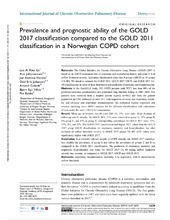| dc.contributor.author | Le, Lan Ai Kieu | en_US |
| dc.contributor.author | Johannessen, Ane | en_US |
| dc.contributor.author | Hardie, Jon Andrew | en_US |
| dc.contributor.author | Johansen, Odd Erik | en_US |
| dc.contributor.author | Gulsvik, Amund | en_US |
| dc.contributor.author | Vikse, Bjørn Egil | en_US |
| dc.contributor.author | Bakke, Per S. | en_US |
| dc.date.accessioned | 2020-05-14T10:29:17Z | |
| dc.date.available | 2020-05-14T10:29:17Z | |
| dc.date.issued | 2019-07-23 | |
| dc.Published | Le, Johannessen A, Hardie JA, Johansen OE, Gulsvik A, Vikse BE, Bakke PS. Prevalence and prognostic ability of the GOLD 2017 classification compared to the GOLD 2011 classification in a Norwegian COPD cohort. The International Journal of Chronic Obstructive Pulmonary Disease. 2019;14:1639-1655 | eng |
| dc.identifier.issn | 1176-9106 | |
| dc.identifier.issn | 1178-2005 | |
| dc.identifier.uri | https://hdl.handle.net/1956/22260 | |
| dc.description.abstract | Rationale: The Global Initiative for Chronic Obstructive Lung Disease (GOLD) 2017 is based on an ABCD assessment tool of symptoms and exacerbation history and grade 1–4 of airflow limitation severity, facilitating classification either into 4 groups (ABCD) or 16 groups (1A-4D). We aimed to compare the GOLD 2011, GOLD 2017 ABCD, and GOLD 2017 1A-4D classifications in terms of their distribution and prediction of mortality and hospitalizations. Methods: In the GenKOLS study, 912 COPD patients with FEV1 less than 80% of the predicted answered questionnaires and performed lung function testing in 2003–2005. The patients were recruited from a hospital patient registry (n=662) and from the general population (n=250), followed up until 2011 with respect to all-cause and respiratory mortality, and all-cause and respiratory hospitalizations. We performed logistic regression and receiver operating curve (ROC) analyses for the different classifications with estimations of area under the curve (AUC) for comparisons. Results: Mean age at baseline was 60 years (SD 11), 55% were male. Mean duration of follow-up was 91 months. By GOLD 2011, 21% were classified as group A, 29% group B, 6% group C, and 43% as group D, corresponding percentages for GOLD 2017 were: 25%, 52%, 3%, and 20%. The GOLD 2011 classification had higher AUC values than the GOLD 2017 group ABCD classification for respiratory mortality and hospitalization, but after inclusion of airflow limitation severity in GOLD 2017 groups 2A–4D, AUC values were significantly higher with GOLD 2017. Conclusion: In a clinically relevant sample of COPD patients, the GOLD 2017 classification doubles the prevalence of group B and halves the prevalence of groups C and D as compared to the GOLD 2011 classification. The prediction of respiratory mortality and respiratory hospitalization was better for GOLD 2017 2A–4D taking airflow limitation severity into account, as compared to GOLD 2017 ABCD and GOLD 2011. | en_US |
| dc.language.iso | eng | eng |
| dc.publisher | Dove Medical Press | eng |
| dc.rights | Attribution-NonCommercial CC BY-NC | eng |
| dc.rights.uri | https://creativecommons.org/licenses/by-nc/3.0 | eng |
| dc.title | Prevalence and prognostic ability of the GOLD 2017 classification compared to the GOLD 2011 classification in a Norwegian COPD cohort | en_US |
| dc.type | Peer reviewed | |
| dc.type | Journal article | |
| dc.date.updated | 2019-12-13T13:53:59Z | |
| dc.description.version | publishedVersion | en_US |
| dc.rights.holder | Copyright 2019 Le et al. | |
| dc.identifier.doi | https://doi.org/10.2147/copd.s194019 | |
| dc.identifier.cristin | 1740917 | |
| dc.source.journal | The International Journal of Chronic Obstructive Pulmonary Disease | |

